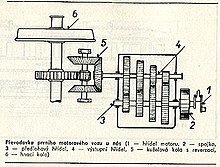ČSD series M 210.0
| ČSD series M 210.0 | |
|---|---|
| Numbering: | M 210.001 |
| Number: | 1 |
| Manufacturer: | Vagonka Studénka Studénka |
| Year of construction (s): | 1925 |
| Retirement: | 1939 |
| Axis formula : | (1A) '(A1)' |
| Gauge : | 1435 mm ( standard gauge ) |
| Length over buffers: | 13,600 mm |
| Length: | 12,300 mm |
| Height: | 3,961 mm |
| Trunnion Distance: | 8,550 mm |
| Bogie axle base: | 1,600 mm |
| Total wheelbase: | 10,150 mm |
| Empty mass: | 20 t |
| Service mass: | 26 t |
| Wheel set mass : | 5 t |
| Top speed: | 45 km / h |
| Installed capacity: | 100 hp |
| Wheel diameter: | 850 mm |
| Motor type: | DWK |
| Motor type: | 6-cylinder gasoline engine |
| Power transmission: | mechanically |
| Train brake: | KNORR |
| Seats: | 55 (3rd class) |
| Classes : | 3. |
The vehicle of the M 210.0 series was a four-axle benzene-mechanical multiple unit for the local railway traffic of the former Czechoslovak State Railways (ČSD). It was the first railcar to be taken over by the State Railways and was one of the mainstays in the development of the first generation of motor vehicles .
History and commitment
In 1925 this four-axle motor vehicle was purchased from the Studenka wagon factory in Studénka . The main unit came from the DWK .
The surprisingly low weight and robust construction later served as a model for further railcar developments. The car was handed over to normal traffic on the Zaječí – Hodonín line on September 2, 1925, making it the first ČSD line operated by motor vehicles.
After just a few days, some disadvantages of the motor vehicle became apparent, such as the susceptibility of the engine to malfunction and the odor nuisance of the passenger compartment from the combustion engine. It was then withdrawn from traffic on September 7, 1925 and reconstructed in the Severočeská Vagónka wagon factory in Česká Lípa . The original Mercedes engine has been replaced by one from TATRA with the same power. To what extent the car was then used according to the schedule cannot be found in the literature. It was retired in 1939.
This vehicle was subject to the first technical and police inspection at the state railway. It showed the mobile use and possibilities for use on other railway lines. In particular, it was general cargo traffic where the use of motor vehicles was expected to be of benefit.
technical features
The vehicles were powered by a 6-cylinder in-line petrol engine from DWK . It was a water-cooled, six-cylinder, four-stroke gasoline engine from the Mercedes brand , which delivered 100 hp at 1400 rpm. The cylinder diameter was 140 mm, the piston stroke was 160 mm. The power was transmitted mechanically via a gearbox from the same manufacturer. The individual gears were controlled by hand. The clutch that connected the transmission to the combustion engine was operated with a pedal.
The motor car had two bogies, between which the drive unit, which was mounted in the frame of the car, was located. The torque was transmitted by six cardan shafts to the inner axle of the bogie, which resulted in the axle sequence (1A) (A1). The engine took up a large space and protruded into the passenger compartment, where it was covered with a hood. The only compartment for the passengers was heated by the engine cooling water.
The motor vehicle had the automatic traction brake of the Knorr type , each axle was braked on one side. The entire car was controlled from both driver's cabs at the top of the car. The driver's cabs were separated from the entry area by a plate.
See also
literature
- Jindrich Bek, Josef Janata, Jaroslav Veverka: Malý atlas lokomotiv 2. Elektrická a motorová trakce. Nadas Publishing House, Prague 1969
